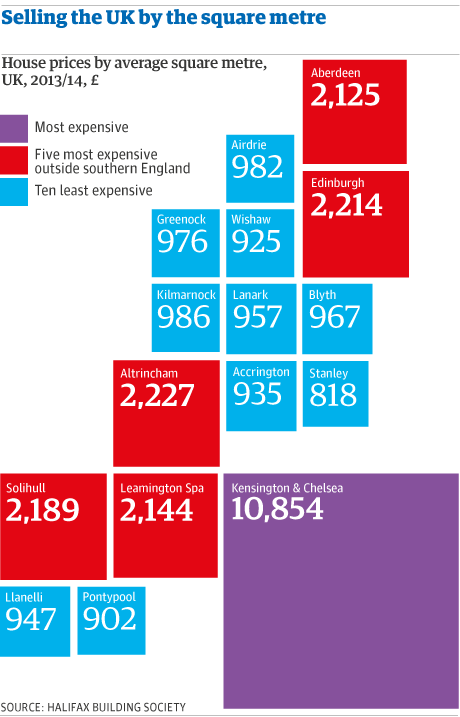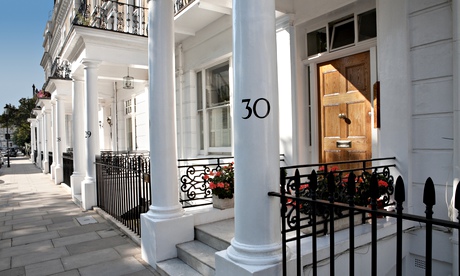Kensington and Chelsea is the most expensive place to buy a home in the UK with one square metre costing £10,854, according to new research that highlights the huge house-price differences between the south-east and the rest of the country.
The London borough's average square metre price is 13 times the value of the same area of floorspace in Britain's cheapest area, Stanley in County Durham. There, a square metre costs £818.
The report by the mortgage lender Halifax found that the top 20 most expensive areas in Britain are all London boroughs. Furthermore, the 48 most expensive areas in the report are all in London and the south-east.
Craig McKinlay, mortgages director at Halifax, said: "House price per square metre is a useful measure for house price comparison because it helps to adjust for differences in the size and type of properties between locations.
"While there are areas in central London that are more expensive than anywhere else in the country, there are notable pockets outside the south-east where property also has a high price per square metre."

The most expensive places outside southern England included Edinburgh, Altrincham near Manchester, which is reputedly popular with Premier League footballers, Solihull in the West Midlands, Leamington Spa in Warwickshire, and Aberdeen.
The least expensive areas were led by Stanley, followed by Pontypool in Wales, Wishaw in Scotland and Accrington in the north-west.
The research also highlighted the capital as seeing the fastest rises in prices per square metre, suggesting the divide between London prices and those outside the capital will widen further.
The 10 areas recording the highest house-price growth per square metre over the past five years were all London boroughs. Lambeth recorded the biggest increase, with prices up 61% over the past five years, followed by Kensington and Chelsea with a 56% rise. That compares with a 13% rise nationally per square metre since 2009.
The research is likely to intensify concerns about the challenges facing people, especially those in the south-east, in getting on to the property ladder. One square metre in the most expensive part of London is equivalent to five months' gross earnings for the average full-time worker.
Against a backdrop of warnings that Britain is headed for another housing bubble, the Bank of England unveiled measures last week to curb the riskiest mortgage lending.
The Bank of England's governor, Mark Carney, announced the first limits on the mortgage market in 30 years, restricting the amount that homeowners can borrow relative to their income and tightening the affordability tests that would-be homeowners face when applying for a mortgage. However, he acknowledged there would be no immediate impact on fast-rising property values, and both lenders and housebuilders appeared relieved that the clampdown was not more draconian.
Economists say that while the Bank's action may cut the risk of a housing market boom and bust, the UK still suffers from a chronic shortage of housing that has helped push up prices.
A separate report on Monday ranks the UK as the third worst for housebuilding in Europe, when population growth is taken into account.
The property firm Countrywide says that over the past decade, UK housebuilding fell by 35%, and that Britain built among the fewest number of new homes out of all the countries in Europe relative to its population growth, meaning it failed to address long-term under-supply issues. Only Luxembourg and Switzerland have been worse at building to keep up with population growth, Countrywide said. Central and eastern European countries had performed best.
Countrywide's chief executive, Grenville Turner, said: "The 2008 downturn in construction should not disguise the fact that the UK has failed to build the required number of new homes over a much longer period of time.
"A long-term lack of housebuilding has meant that the UK was amongst the least well prepared countries to deal with the fall in housbuilding in 2008."
Countrywide's quarterly review of the UK property market was more upbeat about the support offered by Help to Buy, the government scheme designed to kickstart the housing market that was launched last year.
While some have criticised Help to Buy for driving up house prices too quickly, Countrywide said its research suggested the scheme had supported those buyers who most needed help in getting on to the property ladder.
Fifty-five per cent of those who have bought a property using Help to Buy had moved from the private rented sector, Countrywide said. Help to Buy purchasers who previously lived with their family accounted for 30% of those using the scheme.


